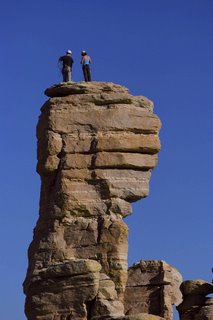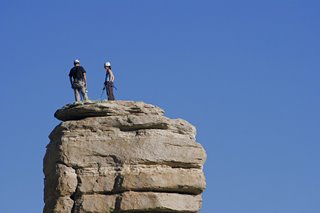Click on the images to see a larger version.
All of the images on this site are copyrighted material and may not be used without written permission of the owner. If you would like to use or purchase prints any of these images, please visit Full Moon Photography for more information.
All of the images here have been reduced in size to at least 1/6 the original and then compressed for display.
Monday, October 30, 2006
Sunday, October 29, 2006
Hoo Doo Climbers
 On a recent trip up into the Catalinas with a friend, we stopped at Windy Point Vista to enjoy the view of Tucson from this location. These climbers were just reaching the top of the Hoo Doo as we got out of the car, so I nissed catching the climax of their climb.
On a recent trip up into the Catalinas with a friend, we stopped at Windy Point Vista to enjoy the view of Tucson from this location. These climbers were just reaching the top of the Hoo Doo as we got out of the car, so I nissed catching the climax of their climb.Canon 20D - 1/2000th, 168mm @ f/ 5.6, ISO 100
Saturday, October 28, 2006
Friday, October 27, 2006
Thursday, October 26, 2006
The view that greeted me
 These images from yesterday morning have been a bit out of order. When I left the dome, this is the view that greeted me. Typically the valley below and the Galiuros mountains beyond are visible, but these mountains of white provided an interesting substitute.
These images from yesterday morning have been a bit out of order. When I left the dome, this is the view that greeted me. Typically the valley below and the Galiuros mountains beyond are visible, but these mountains of white provided an interesting substitute.Canon 20D - 1/60th, 20mm @ f/ 22, ISO 100
View from the Peak
 Here is the morning view out to the west from the peak, directly behind the 60" dome. Hidden by the cloud layer lies the town of Catalina, over a mile below.
Here is the morning view out to the west from the peak, directly behind the 60" dome. Hidden by the cloud layer lies the town of Catalina, over a mile below.This is the condition I wish I had the night before. The layer of moist air was above the valley, but below the peak of Mt. Lemmon. If nature had cooperated, this layer of clouds would have blocked all of the light coming up from Tucson and the other towns around the Santa Catalinas and the skies over Mt. Lemmon would have been exceedingly dark. Instead I was in clouds and rain all night.
Canon 20D - 1/125th, 20mm @ f/ 22, ISO 100
Wednesday, October 25, 2006
Cloudy Catalinas
 While the peak of Mt. Lemmon was in the clouds the night before, making observatoins impossible, the broken layer of clouds was below the peaks about 9am when I was heading back down to Tucson.
While the peak of Mt. Lemmon was in the clouds the night before, making observatoins impossible, the broken layer of clouds was below the peaks about 9am when I was heading back down to Tucson.This view is from above Willow Canyon near M.P. 10 looking south towards the front range and Tucson beyond.
Canon 20D - 1/30th, 55mm @ f /22, ISO 100
Not an Orionid
 The only meteor that I caught duirng the entire night's worth of images is the one visible at the upper right. Looking closely at the trajectory against the background stars, it is clear this one isn't an Orionid. Strange considering this was to be when the Orioninds should have been most active. The meteors that make up the Orionids are small grains the size of sand that come from Halley's Comet which vaporize in a flash of light about 50 miles above Earth's surface. Spordaic meteors, like this one, can't be traced back to any one part of the sky and a few can been seen every hour during any clear night.
The only meteor that I caught duirng the entire night's worth of images is the one visible at the upper right. Looking closely at the trajectory against the background stars, it is clear this one isn't an Orionid. Strange considering this was to be when the Orioninds should have been most active. The meteors that make up the Orionids are small grains the size of sand that come from Halley's Comet which vaporize in a flash of light about 50 miles above Earth's surface. Spordaic meteors, like this one, can't be traced back to any one part of the sky and a few can been seen every hour during any clear night.Canon 20D - 30 seconds, 20mm @ f /1.8, ISO 800
Tuesday, October 24, 2006
Orion over the 60" dome
 I tried a different angle than I usually shoot for animations during this past run at the 60" I was hoping to catch a few Orionid meteors as well as the dome rotating in the series but I didn't have much success. The meteors are called "Orionids" because the radiant, or constellation they seem to be coming from is Orion, the Hunter. Orion is one constellation that almost everyone knows and can been seen everywhere on Earth since it stradles the celestial equator. This time of year Orion can be seen climbing over the eastern horizon a few hours before midnight.
I tried a different angle than I usually shoot for animations during this past run at the 60" I was hoping to catch a few Orionid meteors as well as the dome rotating in the series but I didn't have much success. The meteors are called "Orionids" because the radiant, or constellation they seem to be coming from is Orion, the Hunter. Orion is one constellation that almost everyone knows and can been seen everywhere on Earth since it stradles the celestial equator. This time of year Orion can be seen climbing over the eastern horizon a few hours before midnight.Canon 20D - 30 seconds, 20mm @ f /1.8, ISO 800
Wednesday, October 18, 2006
"T" for Telescopes?
 NO I didn't fall off of Earth's edge! Just been busy with a number of things.
NO I didn't fall off of Earth's edge! Just been busy with a number of things.I had a productive run at the Schmidt finding six new NEOs even though I had poor weather the first night, high winds the last night and crummy seeing all three nights. This image was taken on the night of high winds and I'm glad the camera didn't get blown over! This shot is of both the Schmidt dome and the Kuiper dome on Mt. Bigeow. Two unidentified satellites cross paths hundreds of kilometers over head. The one forming the top of the "T" is in a lower orbit and crossing the sky at a more rapid pace.
Canon 20D - 30 second, f/ 1.8, ISO 200
Thursday, October 05, 2006
This cat cracks me up!
 Sydney keeps me laughing. A few days after I first got her, I couldn't find her anywhere. On my second or third walk around the house searching for her, I noticed a lump under the bed covers that shouldn't have been there. Sure enough, it was her. She figured out how to lift up the edge of the blanket and crawl underneath. Now I know to look under the covers for her and am careful when I lay down on the bed.
Sydney keeps me laughing. A few days after I first got her, I couldn't find her anywhere. On my second or third walk around the house searching for her, I noticed a lump under the bed covers that shouldn't have been there. Sure enough, it was her. She figured out how to lift up the edge of the blanket and crawl underneath. Now I know to look under the covers for her and am careful when I lay down on the bed.This snapshot is of one of her latest tricks, just covering her head with a handy tee shirt. I guess it is more comfortable then covering her eyes with her front legs.
Canon 20D - 1/60th, 51mm @ f/8, ISO 200, On camera flash
Monday, October 02, 2006
60" Bathed in Moonlight
 The Mt. Lemmon Survey 60" telescope works the southern ecliptic as the first quarter moon of September illuminates the scene. Polaris, or the North Star is the brightest star seen directly over the telescope. Polaris is at the end of the handle of the "Little Dipper" (Ursa Minor) which is upside down and curving towards the left in this image.
The Mt. Lemmon Survey 60" telescope works the southern ecliptic as the first quarter moon of September illuminates the scene. Polaris, or the North Star is the brightest star seen directly over the telescope. Polaris is at the end of the handle of the "Little Dipper" (Ursa Minor) which is upside down and curving towards the left in this image.Canon 20D - 30 seconds, 20mm @ f/1.8, ISO 400




